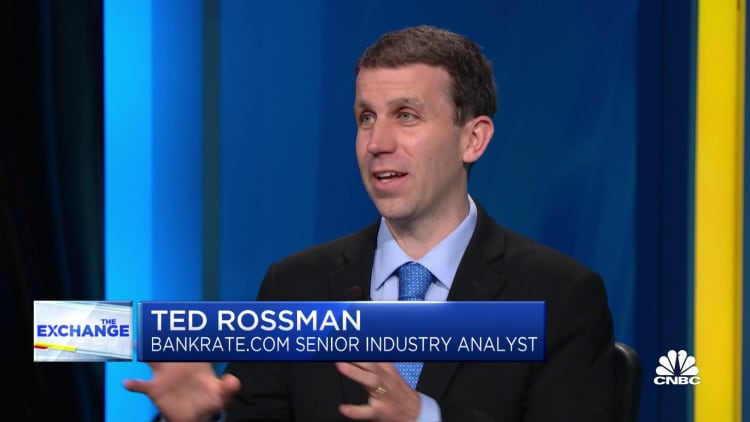
After more than a year of steady rate hikes, the Federal Reserve held its target federal funds rate steady Wednesday.
For households, however, that offers little relief from record-high borrowing costs.
“It’s not like rates will go down,” said Tomas Philipson, University of Chicago economist and a former chair of the White House Council of Economic Advisers.
In fact, borrowing costs are likely to climb higher in the second half of the year: Fed officials projected another two quarter percentage point moves are on the way before the end of 2023.
More from Personal Finance:
Even as inflation rate subsides, prices may stay higher
Here’s the inflation breakdown for May 2023, in one chart
Who does inflation hit hardest? Experts weigh in
Since March 2022, the central bank has hiked its benchmark rate 10 consecutive times to a targeted range of 5%-5.25%, the fastest pace of tightening since the early 1980s. Inflation has started to cool but still remains well above the Fed’s 2% target.
At the same time, borrowers are paying more on credit cards, student loans and other types of debt.
What the federal funds rate means for you
Wage growth hasn’t been able to keep pace with higher prices for many Americans. As a result, most households are getting squeezed and are going into debt just when borrowing rates reach record highs, Philipson said.
“They are getting hammered,” he added.
The exterior of the Marriner S. Eccles Federal Reserve Board Building is seen in Washington, D.C., June 14, 2022.
Sarah Silbiger | Reuters
The federal funds rate, which is set by the central bank, is the interest rate at which banks borrow and lend to one another overnight.
Although that’s not the rate consumers pay, the Fed’s moves still affect the borrowing and savings rates they see every day. The Fed’s current benchmark rate is at its highest since August 2007.
Here’s a breakdown of how that affects consumers:
Credit cards
Credit card annual percentage rates are now more than 20%, on average — an all-time high. Further, with most people feeling strained by higher prices, more cardholders carry debt from month to month.
Today’s credit card rates are likely as high as they’ve been in decades.
Matt Schulz
chief credit analyst at LendingTree
For those who carry a balance, there’s not much relief in sight, according to Matt Schulz, chief credit analyst at LendingTree.
“The truth is that today’s credit card rates are likely as high as they’ve been in decades, and they’re probably going to still creep higher in the immediate future, even though the Fed chose not to raise rates this month,” he said.
Home loans
Although 15-year and 30-year mortgage rates are fixed, and tied to Treasury yields and the economy, anyone shopping for a new home has lost considerable purchasing power, partly because of inflation and the Fed’s policy moves.
Rates are now off their recent peak but not by much. The average rate for a 30-year, fixed-rate mortgage currently sits near 6.7%, according to Freddie Mac, down slightly from October’s high but still well above a year ago.
“Mortgage rates decreased after a three-week climb,” said Sam Khater, Freddie Mac’s chief economist. “While elevated rates and other affordability challenges remain, inventory continues to be the biggest obstacle for prospective homebuyers.”
Other home loans are more closely tied to the Fed’s actions. Adjustable-rate mortgages, or ARMs, and home equity lines of credit, or HELOCs, are pegged to the prime rate. Most ARMs adjust once a year after an initial fixed-rate period. But a HELOC rate adjusts right away. And already, the average rate for a HELOC is up to 8.3%, the highest in 22 years, according to Bankrate.
Auto loans
The average rate on a five-year new car loan is now 6.87%, the highest since 2010, according to Bankrate.
Keeping up with the higher cost has become a challenge, research shows, with more borrowers falling behind on their monthly loan payments.
Student loans
Darren415 | Istock | Getty Images
For now, anyone with existing federal education debt will benefit from rates at 0% until the payment pause ends, which the U.S. Department of Education expects could happen in the fall.
Private student loans tend to have a variable rate tied to the Libor, prime or Treasury bill rates — and that means that those borrowers are already paying more in interest. How much more, however, varies with the benchmark.
Savings accounts
While the Fed has no direct influence on deposit rates, the yields tend to be correlated to changes in the target federal funds rate. The savings account rates at some of the largest retail banks, which were near rock bottom during most of the Covid pandemic, are currently up to 0.4%, on average.
Thanks, in part, to lower overhead expenses, top-yielding online savings account rates are now over 5%, the highest since 2008′s financial crisis, according to Bankrate.
Since the Fed skipped a rate hike at this meeting, those deposit rate increases are likely to slow, according to Ken Tumin, founder of DepositAccounts.com.
Subscribe to CNBC on YouTube.
